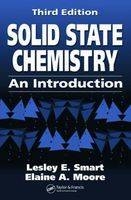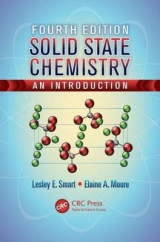
Solid State Chemistry
Nelson Thornes Ltd (Verlag)
978-0-7487-7516-3 (ISBN)
- Titel erscheint in neuer Auflage
- Artikel merken
Intended for first- and second-year undergraduates, this introduction to solid state chemistry includes practical examples of applications and modern developments to offer students the opportunity to apply their knowledge in real-life situations. The third edition of Solid State Chemistry: An Introduction has been comprehensively revised and updated. Building a foundation with a thorough description of crystalline structures, the book presents a wide range of the synthetic and physical techniques used to prepare and characterize solids. Other fundamental discussions include: bonding, superconductivity, and electrochemical, magnetic, optical, and conductive properties. The authors have added sections on fuel cells and electrochromic materials; conducting organic polymers, organic superconductors, and fullerenes; mesoporous solids and ALPOs; photonics; giant magnetoresistance (GMR) and colossal magnetoresistance (CMR); and p-wave (triplet) superconductors. The book also includes a completely new chapter, which examines the solid state chemical aspects of nanoscience. Each chapter contains a set of review questions and an accompanying solutions manual is available.
Solid State Chemistry: An Introduction, Third Edition is written in a clear, approachable style that enhances the material by integrating its concepts in the context of current applications and areas of promising research.
AN INTRODUCTION TO CRYSTAL STRUCTURES
Introduction
Close-Packing
Body-Centred and Primitive Structures
Symmetry
Lattices and Unit Cells
Crystalline Solids
Lattice Energy
Conclusion
Questions PHYSICAL METHODS FOR CHARACTERIZING SOLIDS
Introduction
X-Ray Diffraction
Powder Diffraction
Single Crystal X-Ray Diffraction
Neutron Diffraction
Electron Microscopy
X-Ray Absorption Spectroscopy
Solid State Nuclear Magnetic Resonance Spectroscopy (MAS) NMR
Thermal Analysis
Scanning Tunnelling Microscopy (STM) and Atomic Force Microscopy (AFM)
Temperature Programmed Reduction (TPR)
Other Techniques
Questions PREPARATIVE METHODS
Introduction
High Temperature Ceramic Methods
Microwave Synthesis
Combustion Synthesis
High Pressure Methods
Chemical Vapour Deposition (CVD)
Preparing Single Crystals
Intercalation
Choosing a Method
Questions BONDING IN SOLIDS AND ELECTRONIC PROPERTIES
Bonding in Solids — Free Electron Theory
Bonding in Solids – Molecular Orbital Theory
Semiconductors — Si and Ge
Bands in Compounds — Gallium Arsenide
Bands in d-Block Compounds — Transition Metal Monoxides
Questions DEFECTS AND NON-STOICHIOMETRY
Point Defects — An Introduction
Defects and their Concentration
Ionic Conductivity in Solids
Solid Electrolytes
Photography
Colour Centres
Non-Stoichiometric Compounds
Planar Defects
Three-Dimensional Defects
Electronic Properties of Non-Stoichiometric Oxides
Conclusions
Questions CARBON-BASED ELECTRONICS
Introduction
Polyacetylene and Related Polymers
Molecular Metals
Polymers and Ionic Conduction – Rechargeable Lithium Batteries
Carbon
Questions ZEOLITES AND RELATED STRUCTURES
Introduction
Composition and Structure
Synthesis of Zeolites
Structure Determination
Uses of Zeolites
Mesoporous Aluminosilicate Structures
Other Framework Structures
New Materials
Clay Minerals
Postscript
Questions OPTICAL PROPERTIES OF SOLIDS
Introduction
The Interaction of Light with Atoms
Absorption and Emission of Radiation in Semiconductors
Optical Fibres
Photonic Crystals
Questions MAGNETIC AND DIELECTRIC PROPERTIES
Introduction
Magnetic Susceptibility
Paramagnetism in Metal Complexes
Ferromagnetic Metals
Ferromagnetic Compounds — Chromium Dioxide
Antiferromagnetism — Transition Metal Monoxides
Ferrimagnetism — Ferrites
Giant, Tunnelling, and Colossal Magnetoresistance
Electrical Polarisation
Piezoelectric Crystals — a-Quartz
The Ferroelectric Effect
Questions SUPERCONDUCTIVITY
Introduction
Conventional Superconductors
High Temperature Superconductors
Ferromagnetic Superconductors
Uses of High Temperature Superconductors
Questions NANOSCIENCE
Introduction
Consequences of the Nanoscale
Examples
Manipulating Atoms and Molecules
| Erscheint lt. Verlag | 24.6.2005 |
|---|---|
| Zusatzinfo | Inserts follow pgs 196 & 356; 18 Illustrations, color; 338 Illustrations, black and white |
| Verlagsort | Cheltenham |
| Sprache | englisch |
| Maße | 156 x 235 mm |
| Gewicht | 612 g |
| Themenwelt | Naturwissenschaften ► Chemie ► Physikalische Chemie |
| ISBN-10 | 0-7487-7516-1 / 0748775161 |
| ISBN-13 | 978-0-7487-7516-3 / 9780748775163 |
| Zustand | Neuware |
| Informationen gemäß Produktsicherheitsverordnung (GPSR) | |
| Haben Sie eine Frage zum Produkt? |
aus dem Bereich



